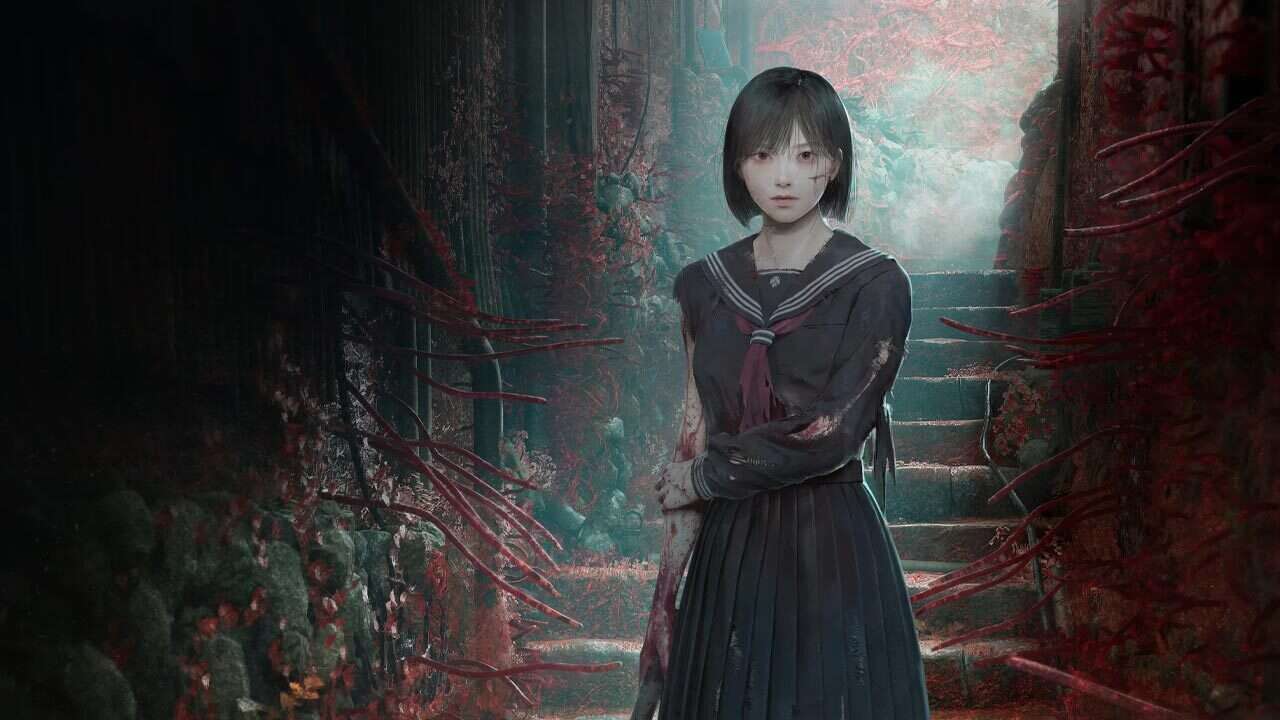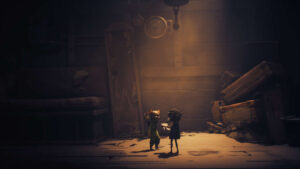As I sat down for the first of many discussions with the Silent Hill f team during my trip to Konami’s Tokyo headquarters, longtime series composter Akira Yamaoka mentioned there was one philosophy in particular that guided his work on the upcoming title: wabi-sabi. Though I certainly won’t claim to be the best person to succinctly summarize this ideology, as I have always understood it, wabi-sabi is about finding beauty in the transient nature of life–in imperfection, impermanence, aging, and even decay. According to Yamaoka, capturing “the feeling of the passing of time” was something he strived to do with his music; based on the time I spent with the game and music I encountered I think he succeeded. But more than that, Yamaoka made me realize just why Silent Hill f was so affecting, and why I can’t stop thinking about the time I spent playing it two weeks later.
In Silent Hill f, beauty and decay are interwoven; flowers melt flesh; clotted rot devours once-proud structures. And yet, all of this grotesquerie is gorgeous, both visually and in the sense of somber it stirs. I was moved by Silent Hill f’s visuals and the sheer artistry on display. But beyond that, I was also moved by how the series’ signature examination of the human mind–which in this case, honed in on the psyche of a young teenage girl being violently thrust towards womanhood–brought me back to my own adolescence; to a time I’ll never again return to and was as isolating and horrifying as it was precious and fundamental. To a part of me that, in a sense, has decayed. Not every game can invoke such a response, especially in just under six hours, and yet, Silent Hill f did.
SILENT HILL f | Official Reveal Trailer
Size:
Want us to remember this setting for all your devices?
Sign up or Sign in now!
Please use a html5 video capable browser to watch videos.
This video has an invalid file format.
Sorry, but you can’t access this content!
Please enter your date of birth to view this video
By clicking ‘enter’, you agree to GameSpot’s
Terms of Use and Privacy Policy
I walked away both enamored and impressed by the time I spent with Silent Hill f. Despite the success of Silent Hill 2’s remake last year, it’s safe to say there was still some speculation as to if the series was truly “back.” I’d now go so far as to say it’s not only back, it’s stronger than ever, and that Silent Hill f has the potential to be the best game in the series.
It’s a bold claim made bolder by the fact that, while a few SIlent Hill games have technically taken place outside the titular Silent Hill, Silent Hill f is the first that seems to be completely removed from the foggy New England town. Instead, Silent Hill f embraces Konami’s idea that Silent Hill is a state of mind. For protagonist Hinako, “Silent Hill” takes shape as a fog- and rot-coated version of her hometown, the fictional rural village of Ebisugaoka, Japan. Silent Hill f distinguishes itself in another way too, as it trades in the series’ more contemporary setting for the late 1960s–a period of time which the Silent Hill f team chose because it felt like the point in time in which the “fantasy” of Japan and its technologically-focused future collided.
Silent Hill f’s events kick off quickly, a fact I appreciated and that kept the lingering sense of dread tangible. After witnessing yet another argument between her parents, Hinako leaves home in search of someone–anyone–to keep her distracted and talk to her. Based on that and her journal entries, we can tell she is a deeply lonely character, even if she seems to have friends and an older sister she deeply admires and who looks out for her; this fact quickly endeared her to me, despite not much having happened at this point. By the time she makes her way down the fog-drenched foothills and to Ebisugaoka’s winding, Kanayama-inspired alleyways, she is thrust into a nightmare scenario befitting the Silent Hill series, albeit with plenty of added friend drama, and a second, yokai-filled spirit world she is sometimes sent to. And yes, the latter is just as fascinating, dark, and beautiful as it sounds; despite loving exploring Ebisugaoka, I was always eager to return.
As a high school-age girl, Hinako is no weapons expert. Though she can certainly swing a metal pipe–and can even wield ceremonial daggers and a naginata when in the spirit world–its advisable to use her track and field experience to evade enemies and pick your battles. A large part of this is because Silent Hill f puts a huge emphasis on resource management, in part by bringing back weapon degradation. Though this can be a contentious choice, I thought it worked extremely well and reflected the game’s overall theme of decay, be it physical or mental.
On the subject of degradation, and in addition to your standard health and stamina bars, Silent Hill f adds a sanity meter to the game, another contentious choice that, when handled poorly, can feel off-putting. However, I found it works well within the game. In addition to avoiding stigmatizing mental health, it also doesn’t feel like just another arbitrary gauge, as it allows Hinanko to engage in a special focus ability that, when activated, better alerts her as to when she can get a critical strike on an enemy. Naturally, closely observing enemies causes her sanity to drain, and when it’s empty, she loses the ability to hone in and is left to find advantageous times on her own.
In addition to weapon degradation, a new layer of resource management is added via the way permanent upgrades work in Silent Hill f. Scattered throughout Ebisugaoka and the spirit world are shrines Hinako can pray at, which saves your progress. Once there, she can also generate faith by enshrining objects, including those used to heal. Once an object is converted into faith, she can then draw omamori, which gives her a random accessory with its own boon, or permanently upgrade one of her stats. This adds an interesting element of choice and strategy: do you hang on to your various healing items to use in battle, or convert them into faith for permanent upgrades? Granted, there are certain items that can solely be enshrined, and plenty of goods that can only be consumed, but when it comes to the rest, it’s up to players to decide how to presume.
There was still some speculation as to if the series was truly ‘back.’ I’d now go so far as to say it’s not only back, it’s stronger than ever, and that Silent Hill f has the potential to be the best game in the series
For the most part, I enjoyed Silent Hill f’s combat. It’s more fluid than previous entries and I loved how weighty Hinako’s swings–and fumblings–felt. It’s nothing revolutionary, but I don’t particularly look for top-tier action in psychological horror games. There is a slight hiccup, though, as managing resources and avoiding engaging in every fight means navigating Ebisugaoka’s tight alleyways. While tight corners, dead-ends, and a close camera add satisfying tension to the game, it can definitely feel a bit frustrating and restrictive when a blood-covered mannequin is stalking you and an arguably too slowly refilling stamina bar keeps winded as you try to dodge its attacks. At a certain point, it made the fear give way to aggravation–and made me desperately long for faster stamina regeneration, even after giving myself a few upgrades.
All this said, the Silent Hill series is arguably better known for its solid level design and puzzles, and Silent Hill f definitely delivers on both fronts. Much like the town of Silent Hill, Ebisugaoka is beautiful, eerie, anxiety-inducing, and a delight to explore–even if it does mean facing off against gore-covered abominations. It’s also deceptively large and feels a lot less linear than you might expect. In fact, there are certain houses and areas that have wholly self-contained stories that, while not mandatory to do, can impact which ending Hinako winds up getting in later playthroughs (all players are locked into the canon ending the first time they play), making exploration all the more enticing.
Also like previous Silent Hill games, Silent Hill f also has a number of great set pieces including vast farmlands, darkened temples, and a dilapidated middle school, the latter of which will delight anyone who loved navigating Silent Hill 2’s apartments. Though the puzzles I encountered weren’t too difficult to solve, they were still fun headscratchers that saw me closely examining scarecrows, deciphering locker code language designed by middle schoolers, sorting through omamori to find the right images to accompany lengthy poems, and more.
While on the subject of things the Silent Hill series does well, I’d be remiss not to mention Silent Hill f’s music and sound design, both of which are phenomenal. Composer Yamaoka does a tremendous job weaving together tracks that sound like Silent Hill while also incorporating more traditional Japanese instrumentation, guttural singing, and a children’s choir. All of this makes the overall experience far more haunting, while the 3D sound design makes it all-encompassing as well.
Even taken purely at surface level, Silent Hill f’s is a great experience, and the story woven in its first five hours–one of a young girl navigating rot-filled alleys and teenage psychological warfare –completely pulled me in. And yet, there was both room and this compulsion to dive deeper; deeper into Hinako’s headspace, and what it meant to be a woman coming of age in 1960s Japan.
It was a subject I was a bit shocked to see so blatantly explored in Silent Hill f, especially considering the current climate. Although horror as a genre is actually phenomenal at facilitating conversations about adolescence and womanhood–and I’d argue that the Silent Hill series itself has done this subtly but extremely well in the past–this isn’t a topic often approached in video games. During my interview with the Silent Hill f team, I asked them if it was their intention to explore gender roles, relationship dynamics between men and women, and the “horrors” of being a teenage girl. Ryukishi07 then told me that not only was it intentional, it was a part of the game he took “a lot of effort into depicting purposefully,” and it shows.
“Since the protagonist is a girl, I believed that it was important to explore the things that would be most intimate and personal to her. From her perspective, it was important relationships–to her family and the ones that she has with her friends,” Ryukishi07 said. “The relationship she has with her family is probably the most intimate and visceral, in a way. So I believe these are parts that I took a lot of effort into depicting purposely.”
Though how things unfold exactly remains to be seen, so far I am incredibly impressed by the confidence, subtlety, and acuteness with which Konami is exploring a young girl’s psyche and how isolating becoming a woman can be. Be it jabs thrown at Hinako regarding how “manly” she speaks, the subtle ways one of her “friends” undermines her femininity in front of one of their male friends, the strain that now exists between her and her aforementioned male friend as attraction becomes a concern, the shallow magazines with articles claiming “a woman is only complete once she is loved,” or, most compellingly, the many journal entries Hinako pens that explain how marriage has ruined her older sister and how her mother and father’s abusive dynamic has affected her, Silent Hill f is unabashed in its efforts to bring players into Hinako’s mind.
And yet, I think there is one other exciting vessel for exploring Hinako’s inner-workings that needs to be touched on: a new, unnamed character that I can already tell is going to be extremely popular in the Silent Hill fandom, the fox-masked man. Though I can’t speak too in depth about his character yet, suffice it to say that those who were *ahem* awakened by Spirited Away’s Haku or Labyrinth’s Jareth are going to love the white haired demon and his k-pop idol good looks–even if there is something vaguely threatening about him. After encountering him a few times throughout the game, my face nearly blushing as I watched him coax Hinako with kind words and lead her through the dark spirit world he seems to inhabit, I decided I needed to ask the Silent Hill f team is they intended to create a character that fans were going to obsess over.
“Yes, that’s the initial answer,” director Al Yang laughed. “There will definitely be people who like him. In the company, I know half of the people are like, ‘Oh, this guy’s a dream boat.’ And the other half is like, ‘I don’t trust this dude.’ It’s very both ways, but that’s good. For us, that’s the kind of interpretation we want–especially as we progress deeper in the story.”
Gallery
The masked man–and the nature of this new “Silent Hill” that Hinako finds herself in–are not the only mysteries to solve in Silent Hill f. Since the game was announced, many have speculated as to what that little red “f” in the game’s title could mean. Though many have been quick to assume that–based on its curvature–it stands for forte, the Silent Hill team has been coy when it comes to revealing what it actually stands for. In fact, based on their comments and the fact that the game has five different endings (yes, including a UFO one), it seems as though it could stand for a number of things, with different players having different interpretations.
“We do have a lot of different meanings infused into the letter F. But that’s something that we would like to leave as an open-ended question for the players to explore and come to their own conclusions,” series producer Motoi Okamoto said.
Fortunately, we won’t have to wait too much longer to get to work on answering these questions and discovering just what that “f” might mean. Silent Hill f launches on September 25, 2025, and will be available on PC, PS5, and Xbox Series X|S.









